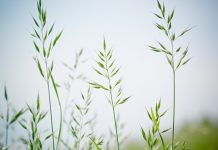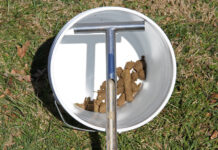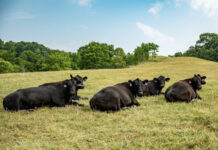In our Pasture For Profit grazing schools we talk about pasture management in terms of keeping pasture plants actively growing and matching livestock nutrient needs to plant growth stage. But now its winter and the plants aren’t growing, so what does winter pasture management entail?
I want graziers to think about winter pasture management in terms of resource management. The most important resource on the farm of the livestock owner who is a grazier is the pasture paddock or the sod base. Even though that pasture or sod base is not actively growing in the winter period, it must be managed to ensure it is ready to be productive when the growing season arrives.
If you have followed this column and/or attended a grazing school, you know that the fall period is a critical time in which plant root reserves must be built up. Leaf area must be maintained. Overgrazing must be avoided. Once the plant is dormant, that leaf area can be grazed off in this winter period.
The goal of winter management is to protect or even improve the sod base while grazing is occurring. That type of management begins with an inventory of pasture paddocks and assigning a rating to the quality of the sod base.
Pasture paddocks can be rated into one of three categories:
Good sod base
This is probably the pasture paddock that has not been overgrazed for at least the past couple of years and that has been managed to maintain good leaf area during the fall of the year. The species mix is desirable, there are no bare spots exposing soil and productivity is good.
Acceptable sod base
This might be a paddock that was mismanaged a little, possibly was overgrazed a few times, or maybe wasn’t managed to allow root reserves to get replenished in the fall, or maybe has some soil pH or fertility issues. It can be a productive paddock but currently the sod base is a little thin, and there may be some bare soil areas.
Poor sod base
This is a paddock that has a number of weeds or undesirable grazing species. The plant cover in some areas is sparse and it is not a productive paddock. After your pasture paddocks have been inventoried and assigned their rating, then winter pasture management begins in earnest.
Let’s consider our pasture management strategies for each type of paddock. Those paddocks with a thick sod base are the most valuable resource, they must be protected.
I have often heard Bob Hendershot, NRCS state grassland specialist, tell grazing school participants that the productivity of a grass sod can continue to increase for a hundred years. Graziers must view their pasture paddocks as a long term resource. When livestock are grazing off the leaf residue they must not be permitted to tear up this sod base.
I have talked with several experienced graziers here in Athens County who say that they do whatever it takes to protect this sod base during the winter period.
Some of them have learned from hard experience that the weight and hoof action of cattle during wet winter periods can beat up the sod and open it up to invasion by weedy species. This is most likely to happen when the cattle are being confined to a limited area as the grazier strives for high forage utilization.
Tips
What are some management strategies that can be used to protect those good sod base paddocks?
Some graziers utilize a heavy use pad and keep livestock off paddocks during wet unfrozen periods. In some cases it may be possible to get cost share funding under the Environmental Quality Incentive Program to put in these pads as part of an integrated grazing management plan.
I know graziers with a seasonal dairy herd that attempt to get a portion of their herd off their farm completely during the winter period to help protect paddocks from getting trampled and tore up. In other cases, decreasing the stocking density by eliminating a back fence as the herd grazes across a stockpiled paddock can help to protect the sod base.
Those paddocks that have an acceptable sod base but have some thin areas are a good candidate for the grazier to utilize hay as a tool to not only provide nutrients for the livestock, but to help improve the pasture paddock.
Nutrients
Every ton of hay contains about 40 pounds of nitrogen, 14 pounds of phosphate and 50 pounds of potash. Remember that grazing animals return better than 80 percent of the nutrients that they take in back to the pasture through their urine and feces.
In addition to the nutrients being provided to those pasture areas where hay is fed, there is the benefit of the organic matter that is added. Then there is the fact that often the hay fed to our livestock contains some mature grass and legume seeds.
Add this all together and the effect is what we have all seen and what experienced graziers count on; the grass growth in areas where hay has been unrolled and fed is greener, thicker and more vigorous than previously in that area.
Notice that unrolling the hay is important to get this improvement. Feeding hay in rings and keeping it concentrated in one area concentrates livestock and the result is often a muddy, torn up area. Yes, lots of nutrients are in that area, but the sod base has been destroyed and some of our annual broadleaf weeds and grasses may be the main beneficiary.
The key here is to view hay as a tool to help manage your important resource; the grass sod.
Sacrifice
Finally, if you have some pasture paddocks that have a poor or thin sod base, they could be considered sacrifice areas during the winter period. Instead of using a heavy use pad, move your livestock to these paddock areas during those wet unfrozen periods. Feed hay and let the livestock trample up these areas.
Use your livestock as a tillage tool and prepare these poor sod base paddocks for renovation. In the spring level off these areas and plant some improved grass and legume species.
The winter period is the time for the management focus of the grazier to shift to a resource management perspective. The resource is the sod base, the foundation of the grass farmer. Taking inventory of the pasture paddocks with respect to the quality of the sod base will aid the grazier in winter management practices.
(Rory Lewandowski is an OSU Extension educator in Athens County.)












